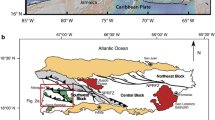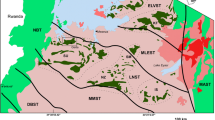Abstract
The lead-zinc bearing Proterozoic rocks of Zawar, Rajasthan, show classic development of small-scale structures resulting from superposed folding and ductile shearing. The most penetrative deformation structure noted in the rocks is a schistosity (S 1) axial planar to a phase of isoclinal folding (F 1). The lineations which parallel the hinges ofF 1 folds are deformed by a set of folds (F 2) having vertical or very steep axial planes. At many places a crenulation cleavage (S 2) has developed subparallel to the axial planes ofF 2 folds, particularly in the psammopelitic rocks. The plunge and trend ofF 2 folds vary widely over the area.
Deformation ofF 2 folds into hook-shaped geometry and development of another set of axial planar crenulation cleavage are the main imprints of the third generation folds (F 3) in the region. In addition to these, there are at least two other sets of cleavage planes with corresponding folds in small scales. More common among these is a set of recumbent and reclined folds (F 4), developed on steeply dipping early-formed planes. Kink bands and associated sharp-hinged folds represent the other set (F 5).
Two major refolded folds are recognizable in the map pattern of the Zawar mineralised belt. The larger of the two, the Main Zawar Fold (MZF), shows a broad hook-shaped geometry. The other large-scale structure is the Zawarmala fold, lying south-west of the MZF. Both the major structures show truncation of lithological units along their respective east ‘limbs’, and extreme variation in the width of formations. The MZF is primarily the result of superimposition ofF 3 onF 2.F 1 folds are relatively smaller in scale and are recognizable in the quartzite unit which responded to deformation mainly by buckle shortening. Large-scale pinching-and-swelling that appears in the outcrop pattern seems to be a pre-F2 feature.
The structural evolutionary model worked out to explain the chronology of the deformational features and the large-scale out-crop pattern envisages extreme east-west shortening following formation ofF 1 structures, resulting in the formation of tight and isoclinal antiforms (F 2) with pinched-in synforms in between. These latter zones evolved into a number of ductile shear zones (DSZs). The east-west refolding of the large-scaleF 2 isoclinal antiforms seems to be the consequence of a continuous deformation and resultant migration of folds along the DSZs. The main shear zone which wraps the Zawar folds followed a curved path.
Because of the penetrative nature of theF 2 movement, the early lineations which were at high angles to the later ones (as is evident in the west of Zawarmala), became subparallel to the trend ofF 2 folding over a large part of the area. Further, the virtually coaxial nature ofF 2 andF 3 folds and the refolding ofF 3 folds by a new set of N-S folds is an indication of continuous progressive deformation.
Similar content being viewed by others
References
Basu P K1982 Zawar lead zinc deposit, India: A prototype synsedimentary Precambrian sulphide deposit;Q. J. Geol. Met. Soc. India,54 78–93
Berthé D, Choukroune P and Jegouzo P 1979 Orthogneiss, mylonite and non co-axial deformation of granites: The example of the south Armorican shear zone;J. Struct. Geol. 1 31–42
Chakraborty A K 1968 Cross-folding in Zawar area, Rajasthan, India;Bull. Geol. Soc. Am. 79 1677–1682
Coward M P 1976 Strain within-ductile shear zone.Tectonophysics 34 181–197
Davis G A, Lister G S and Reynolds S J 1986 Structural evolution of the Whipple and South Mountains shear zones, south western United States;Geology,14 7–10
De Sitter L U 1964 Structural Geology, 3rd ed. (New York: McGraw Hill Book Co.) 552 pp
Drury S A 1990 SPOT image data as an aid to structural mapping in the southern Aravalli hills of Rajasthan, India;Geol. Mag. 127 195–207
Gapais D, Bale P, Choukroune P, Cobbold P R, Mahjoub Y and Marquer D 1987 Bulk kinematics from shear zone patterns: Some field examples;J. Struct. Geol. 9 635–646
Ghosh S K 1993 Structural Geology, Fundamental and Modern Developments. 1st ed. (Oxford: Pergamon Press) 598 pp
Ghosh S K and Sengupta S 1987 Progressive development of structures in a ductile shear zone;J. Struct. Geol. 9 277–287
Heron A M 1953 Geology of central Rajputana;Mem: Geol. Surv. India 79 389
Lin S and Williams P F 1992 The origin of ridge-in-groove slickenside striae and associated steps in an S-C mylonite;J. Struct. Geol. 14 315–321
Mookherjee A 1976 Ore and metamorphism: Temporal and genetic relationships. In Handbook of stratabound and stratiform ore deposits. (Ed.) K H Wolf,Tectonics and metamorphism, (Amsterdam: Elsevier) 4 203–260
Means W D 1987 A newly recognized type of slickenside striation;J. Struct. Geol. 9 585–590
Naha K and Halyburton R V 1974a Early Precambrian stratigraphy of central and southern Rajasthan, India;Precambrian Res. 4 55–73
Naha K and Halyburton R V 1974b Late strain systems deduced from conjugate folds and kink bands in the “Main Railo Syncline”, Udaipur district, Rajasthan, India;Geol. Soc. Am. Bull. 85 251–256
Naha K and Halyburton R V 1977a Structural pattern and strain history of a superposed fold system in the Precambrian of central Rajasthan, India; Structural pattern in the “Main Railo Syncline” central Rajasthan;Precambrian Res. 4 39–84
Naha K and Halyburton R V 1977b Structural pattern and the strain history of a superposed fold system in the Precambrian of central Rajasthan, India II. Strain history;Precambrian Res. 4 85–111
Naha K and Mohanty S 1988 Response of basement and cover rocks to multiple deformation: A study from the Precambrian of Rajasthan, western India;Precambrian Res. 42 77–96
Poddar B C 1965 Stratigraphic position of the BGC of Rajasthan;Curr. Sci. 34 443–484
Powell C McA 1979 A morphological classification of rock cleavage;Tectonophysics 58 21–34
Ramsay J G 1967 Folding and Fracturing of Rocks (New York: McGraw Hill) pp. 568
Ramsay J G and Graham R H 1970 Strain variations in shear belts;Can. J. Earth Sci. 7 786–813
Ramsay J G and Huber MI 1983 The Techniques of Modern Structural Geology, Strain Analysis (London: Academic Press) 307 pp
Ramsay J G and Huber M I 1987 The Techniques of Modern Structural Geology, Folds and Fractures (London: Acad. Press) vol. 2 440 pp
Roy A B 1978 Modification of flexure folds by flattening process examples from the Aravalli rocks of Zawar mine area, Rajasthan;J. Geol. Soc. India 29 21–25
Roy A B 1990 Evolution of the Precambrian crust of the Aravalli mountain range. In: Precambrian continental crust and its economic significance, (Ed.) S M Naqvi, Develop. in Precambrian Geol. (Amsterdam: Elsevier) 8 349–366
Roy A B and Jain A K 1974 Polyphase deformation in the Pb-Zn bearing Precambrian rocks of Zawarmala, District Udaipur, southern Rajasthan. Golden Jub. Vol.;J. Geol. Min. Meta. Soc. India 46 81–86
Roy A B and Nagori D K 1991 Influence of differential basement mobility on contrasting structural style in the cover rocks: An example from early Precambrian rocks east of Udaipur, Rajasthan;Proc. Indian Acad. Sci. (Earth Planet. Sci.) 99 291–308
Roy A B, Nagori D K, Golani P R, Dhakar S P and Chaudhari R 1980 Structural geometry of the rock phosphate bearing Aravalli rocks around Jhamarkotra mines area Udaipur dist., Rajasthan;Indian J. Earth Sci. 7 191–202
Roy A B, Paliwal B S and Goel O P 1971 Superposed folding in the Aravalli rocks of the type area around Udaipur, Rajasthan;J. Geol. Soc. India 12 342–348
Roy A B, Paliwal B S, Shekhawat S S, Nagori D K, Golani P R and Bejarniya B R 1988 Stratigraphy of the Aravalli Supergroup in the type area;Mem. Geol. Soc. India 7 121–138
Singh N N 1988 Tectonic and stratigraphic framework of the lead-zinc sulphide mineralisation at Zawarmala, District Udaipur, Rajasthan;Geol. Soc. India 6 546–564
Skjernaa L 1980 Rotation and deformation of randomly oriented planar and linear structures in progressive simple shear;J. Struct. Geol. 2 101–109
Smith A W 1964 Remobilization of sulphide ore bodies;Economic Geol. 59 930–941
Straczeck J A and Srikantan B 1967 The geology of Zawar lead-zinc area, Rajasthan;India Mem. Geol. Surv. India 92 85 pp.
Author information
Authors and Affiliations
Rights and permissions
About this article
Cite this article
Roy, A.B. Geometry and evolution of superposed folding in the Zawar lead-zinc mineralised belt, Rajasthan. Proc. Indian Acad. Sci. (Earth Planet Sci.) 104, 349–371 (1995). https://doi.org/10.1007/BF02843402
Issue Date:
DOI: https://doi.org/10.1007/BF02843402




